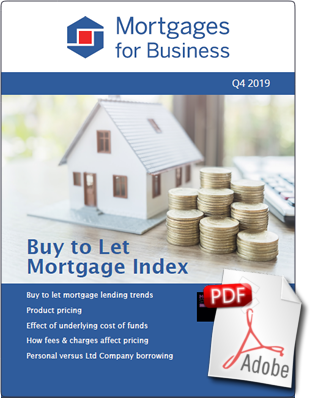Two-year fixed rates grow in popularity among buy-to-let landlords
The percentage of landlords opting for two-year fixed rate buy-to-let mortgage products has reached a 12-month high with more landlords choosing shorter-term products compared to Q4 2018, according to Mortgages for Business. In Q4 2019, the proportion of landlords choosing two-year fixed rates had risen to 26% from just 8% in the previous year. The growing number of landlords opting for shorter-term rates has been fuelled by the shorter Early Repayment Charge (ERC) periods, which are typically attached to these types of products. Shorter ERC periods allow landlords to refinance sooner without occurring a penalty – an option which became more popular in the uncertain political climate at the back end of last year. |
However, despite the majority of landlords (95%) choosing fixed rates over a variable product (down slightly from 97% in the previous quarter) five-year fixed rate products remain the most popular term chosen by 68% of landlords (down from 70% in Q3 and 72% in Q2 2019). This is mainly because lenders are still applying less rigorous stress tests to five-year products than to shorter-term products which, in effect, means landlords can borrow more using them than with their two or three-year counterparts.
There has been an increase in the popularity of the tracker and discounted rate products, up from 2% in Q3 to 4% in Q4 2019 as landlords respond to increased speculation that the Bank Rate could be cut in the near future.
Commenting on the findings, Steve Olejnik, managing director of Mortgages for Business said: “Recent political uncertainty has led more landlords to opt for 2-year fixed rates over longer-term fixed rate products. Landlords are drawn to the shorter Early Repayment Charge periods associated with these types of products, which provide greater flexibility. Given we now have more certainty in the political system, we forecast that landlords may start to look at longer term fixes again in the future.”
Rates available to landlords borrowing via a limited company on average were 0.7% points higher than those available to landlords borrowing personally – up from 0.6% points in the previous quarter. In addition, the number of products available to limited companies for both two-year (288) and five-year fixed rates (322) grew in Q4 2019.
Steve Olejnik said: “More landlords are expanding their portfolios through a limited company which has proven to be a more effective borrowing vehicle both from a tax perspective and financially. Lenders have responded to that and demand has fuelled an increase in the number of products available.
The number of buy-to-let mortgage products available increased by 72 to 1,981 in Q4 2019 up from 1,909 in the previous quarter. In addition, the number of buy-to-let products available to limited companies increased by 51 to 738 up from 687 in Q3 2019.
Steve Olejnik said: “The increase in the number of products available to limited companies gives landlords more choice. Since Brexit was assured by the clear General Election result in December, British house prices have risen at their fastest rate since 2002, according to Rightmove. Houses in Multiple Occupation (HMOs) continued to produce the most substantial yields for landlords handling more complex portfolios, in at 9.2% Q4 2019.”
Published: 17 February 2020






